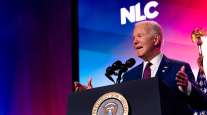Senior Reporter
USDOT Highlights State Benefits in $1T Infrastructure Law

[Stay on top of transportation news: Get TTNews in your inbox.]
A state-by-state summary and analysis from the U.S. Department of Transportation of the recently enacted $1 trillion federal infrastructure bill highlights funding provisions tucked in the law. Included are projects ranging from freight connectivity and transit operations to investments in electric-vehicle infrastructure, all aiming to improve nearly every corner of the country’s transportation landscape.
Specifically, the law targets roads and bridges, but it also establishes a national network of electric vehicle charging stations and seeks to upgrade airports and ports, among other systems.
“Americans rely on our transportation infrastructure every day, to get to work, school, loved ones, and to move goods across our economy,” said Secretary Pete Buttigieg regarding the Infrastructure Investment and Jobs Act on Nov. 18. “The once-in-a-generation investments in the bipartisan infrastructure law will improve people’s lives in every state in the nation by increasing access to safe, clean, reliable transportation.”

Buttigieg
At an event in Detroit, Mich., this month, President Joe Biden emphasized the law’s potential benefits for cities and towns. As he put it, “Nationally, last year, the extreme weather cost the United States of America $99 billion — $99 billion — from hurricanes in Louisiana to 20 inches of rain in the northeast, to fires in the west that literally consumed more land than the entire state of New Jersey, from Cape May to New York. That’s how much has burned to the ground.”
“This law builds back our bridges, our water systems, our power lines, our electric grid better and stronger so fewer Americans will be flooded out of their homes or lose power for days and weeks at a time when a storm hits,” Biden added.
A look at USDOT’s analysis, for instance, determined that under the law Utah will receive $19 million to help prevent crashes and fatalities, especially for cyclists and pedestrians. In addition, Utah can expect to receive approximately $24.7 million over five years in funding to enhance commercial motor vehicle safety programs. Per the law, West Virginia is expected to receive approximately $17.2 million over five years also for commercial motor vehicle safety programs.
California is expected to receive about $384 million over five years for the expansion of an electric vehicle charging network. California also would have the opportunity to apply for grants out of the $2.5 billion available for EV charging infrastructure.
For Georgia, that state can expect to receive approximately $86.8 million over five years in funding to enhance commercial motor vehicle safety programs. Additionally, Georgia is expected to receive $135 million over five years for the expansion of an EV charging network in the state.
Michigan will receive approximately $54 million for highway safety traffic programs, which are meant to improve driver behavior and reduce deaths and injuries from crashes.
Airports in Oklahoma would receive approximately $137 million for development projects over five years. The funding assistance will prioritize airside and needs, such as improving runways, taxiways and airport-owned towers, terminal development projects and noise reduction projects. New York would expect to receive about $11.2 billion over five years to improve public transportation.
The Bipartisan Infrastructure Law is here. But what does it mean for your community?
Check out our latest state-by-state fact sheets to see for yourself https://t.co/GDRUOu04Xw — TransportationGov (@USDOT) November 18, 2021
Overall, the Infrastructure Investment and Jobs Act, signed into law Nov. 15, dedicates more than $100 billion for surface transportation networks, $66 billion for freight and passenger rail operations, $65 billion for rural broadband and $46 billion for climate change programs.
The American Association of State Highway and Transportation Officials, which represents state transportation agencies, applauded the Infrastructure Investment and Jobs Act. “State departments of transportation applaud Congress and the president for getting this important piece of legislation to the finish line, as it provides historic funding increases for federal highway, transit, highway safety, and rail programs and directly addresses equity, climate change, system resiliency, bridge investment and project delivery and environmental review processes,” said Jim Tymon, AASHTO executive director.
Want more news? Listen to today's daily briefing below or go here for more info:




